Nissan Pathfinder Vs Volkswagen Atlas Comparison

There’s a whole lot of crossover between these two crossovers.
Both the Nissan Pathfinder and Volkswagen Atlas come with three rows. There’s a large, naturally-aspirated V6 under each nose, sending power to all four wheels. In the case of these two specific examples, they’re also both red, with twin-five-spoke wheels. They’re both the respective range-toppers of their lineup, too.
Get a Quote on a New Nissan Pathfinder or Volkswagen AtlasThat’s what makes this comparison so interesting. Managing editor Mike Schlee and I spent a week with these two mid-sized SUVs, determined to figure where their respective strengths lie, especially as relatively left-field choices in a crowded segment. Is one the clear choice for families? Let’s find out.
Interior and Cargo Space
Pathfinder: The Pathfinder has a chunky, almost geometric dashboard design. It’s a more modern space, and one more appropriate for a big, burly crossover. Material quality is good too, with soft-touch materials appropriate for something on the far side of $50,000. We also dig the generous storage cubbies in the door panels, as well as the small one directly underneath the shifter.
The Pathfinder’s seats are big and comfy—at least for one of us. “Pathfinder seat does not fit me right,” says managing editor Mike Schlee, “could never find a comfortable seating position. The Atlas is better. Not great, but better.” I found the seats more or less the same up front, in both vehicles, though I did prefer the length of the Nissan’s lower cushion. The VW perch feels higher, which should appeal to those who want an eagle’s eye view of the road ahead.
It’s the same story in the second row for this writer, with no discernible difference in comfort between Japan and Germany. The VW’s extra interior space starts to make itself known here though, with more head- and legroom. Either way, adults will be plenty comfy in the middle of the Pathfinder. The one-touch seat tumble to access the third row is easy to use, though the space it leaves isn’t quite as generous as the VW’s. However, Nissan covers up more of the floor mechanisms, so little ones won’t track as much salt and road gunk into the tracks.
It’s in the third row where the Nissan gives up the most space to its competitor, literally. There’s just 28.0 inches (711 millimeters) of legroom, though headroom is a wholly acceptable 38.3 inches (973 mm). Squeezing three seats back there means everyone better be friendly, too.
Continuing the trend, the Pathfinder is the smaller of the two SUVs when it comes to storing stuff. With all seats in their takeoff position, you’ll find 16.6 cubic feet (470 liters) of storage, which jumps to 45.0 (1,274 L) with the third row folded flat, then 80.5 cubes (2,280 L) with the second row tucked. It’s a small thing, but I like that the Nissan team included velcro patches for the third row folding pullstring. I used the Pathfinder to help a friend move into her new place, and it happily swallowed two small bookcases, a boxed mattress, and the entirety of an Ikea run without issue.
When properly equipped, the Pathfinder can tow up to 6,000 lb (2,722 kilograms).
Atlas: The Atlas has a clean, understated interior, more car-like than the chunky design inside the Pathfinder. Increasing its sense of spaciousness is the light beige interior of our tester. There’s nothing that jumps out here—but it’s also just a wee bit boring. Like the Pathfinder, there’s lots of door panel storage, and a large panoramic moonroof lets even more light in. We found the sightlines out of the Atlas more compromised than the newer Pathfinder, however.
As mentioned above, Mike preferred the seats of the VW here. I had no preference, though I still don’t understand having memory buttons on the seat base instead of the door.
Second-row space is ample for adults. This tester has the optional captain’s chairs, with a clear pass-through between them. If you’d rather, there’s an easy-access lever on the side of the base that folds the seat up and forward for access to the third row. The resulting opening is enough for me to fit comfortably, so it shouldn’t be too much trouble for kids.
The third row is positively palatial compared to the Nissan. There’s 20 percent more legroom (33.7 inches / 856 mm), and a skosh more headroom as well. Sure, you can’t fit three folks back here, but the pair that drop in will be happier for it. The accessible air vents are a nice touch, the small side windows, less so.
Pop that big liftgate and there’s 20.6 cubic feet (583 L) of space for storage, including two cutouts just aft of the wheel arches. Drop the third row for 55.5 cubes (1,572 L); run your Atlas in two-seat mode and there’s a massive 96.8 cubic feet (2,741 L) to fill.
SEE ALSO: Kia Sorento vs Toyota Highlander Hybrid Comparison: Suburban SUV ShowdownBottom Line: Both vehicles have their advantages here. Schlee and I both dig the Pathfinder’s interior design more than the unremarkable VW’s. However, if you’re buying a three-row crossover, we can only assume available space is pretty high on the priority list. And in every way other than maximum seating capacity, the VW has the Pathfinder beat. It sneaks ahead after one category.
Tech and Features
Pathfinder: Nissan prioritized screen space for the latest Pathfinder, dropping in the well-received setup from the redesigned 2021 Rogue. That translates to a 9.0-inch central touchscreen, 12.3-inch digital instrument panel, and 10.8-inch head-up display (HUD). So while that central screen might lack the gee-whiz delight of some competitors’ larger setups, know that it’s a sorted and accessible experience. Response times are quick, and setting up wireless Apple CarPlay is a cinch. Added bonus: a physical button to switch back to the native setup. It’s rarer than you’d think.
Both of us like the digital instrument panel, too. I’m not big on the weird forced-perspective dials, but it’s easy to swap to the regular setup. “Can customize all the information I need right in front of me,” read Schlee’s notes. Plus, there’s the important info above, in the HUD. If I want to nitpick, it doesn’t show smartphone directions, only the native stuff. And the instrument panel only shows a local map if you’ve set a location. No dealbreakers.
The Pathfinder’s 13-speaker Bose sound system drew zero complaints—but no compliments, either. Same goes for its heated and ventilated seats, and the heated steering wheel gets mildly warm at best. Six USB plugs and a wireless charge pad means everyone should be able to keep their devices fully juiced. And with tri-zone climate control, they should stay comfortable, too.
Nissan stuffs the Pathfinder full of handy safety assists. Alongside all the expected driver aids, there’s a driver attention alert, traffic sign recognition, and a high-quality 360-degree camera.
Atlas: Volkswagen’s MIB3 infotainment screen is starting to look a little weathered. It runs well enough on this 8.0-inch screen, and includes wireless phone mirroring like the Nissan. The VW’s stronger tech toy is its digital instrument panel. While not as outright adjustable as the one in the Nissan, it makes up for that with a cleaner display. It also can display a map without a destination if, like me, you’d like a rough idea of your surroundings. The screen does look a little lost in that sea of surrounding black plastic, however. The Atlas also lacks a head-up display.
“Always been a fan of the Fender audio systems in Volkswagens, still am,” says Mike. I’m with him, thanks to the richer sound. The seven USB ports in the cabin count in the VW’s favor, too. I’m not a fan of the wireless charge pad, however: it’s angled at just the right angle to ensure the phone never actually stays charging for more than a few minutes.
The Volkswagen’s seats get very warm when requested; the steering wheel is slower, but ends up keeping hands toasty better than the Nissan’s tiller.
Like the Pathfinder, the Atlas comes with nearly every safety assist its parent company can throw at it. It matches the Nissan on most fronts, including rear cross-traffic alert, automated emergency braking, adaptive cruise control, and driver attention alert, while also including a parking assist.
SEE ALSO: Honda Odyssey vs Toyota Sienna Comparison: Minivan Mix-n-MatchBottom Line: Just like the last category, we’re left with a pretty even mix of pros and cons for both of these SUVs. Overall, the Nissan’s infotainment suite is more impressive, while we preferred the VW’s audio system and stronger climate setup.
Powertrain, Driving Feel, and Fuel Economy
Pathfinder: No matter which Pathfinder you choose, a 3.5-liter naturally aspirated V6 sits underhood. Power is rated at a perfectly functional 284 horsepower, with 259 pound-feet of torque backing that up. Nissan has ditched the old continuously variable transmission, dropping the nine-speed automatic from the Frontier in here instead. FWD is standard in the US; AWD is optional, and standard in Canada.
On the move, the drivetrain does what is needed of it. Mike isn’t a fan, much preferring the Volkswagen’s setup—and he says it even sounds better, which is true. The Pathfinder is wholly adequate in the city; it’s out on the highway, when the driver needs that entire corral at attention for passing, that it can feel slightly ponderous. Here, only generous stabs at the throttle awaken the V6, so you’re left with a balancing act of too little or too much power.
As I noted on my Pathfinder first drive last summer, switching to the Sport driving mode does make the SUV’s responses more natural. That extends to the steering too, which gains a useful amount of heft and resistance. Running around in Sport mode would make the Pathfinder thirstier than it already is though: it averaged 20 mpg (11.8 L/100 km), matching its official city rating. The EPA calls for a 22 mpg average, and given the cold temps and ample snow during the week, this wasn’t a bad result.
Of the two vehicles, the Nissan struggled more with the white stuff. In fact, it got temporarily stuck when lining up that lead photo—though at least some of that can be chalked up to user error, as I hooked into the deep stuff. Either way, it illustrated how, even in Snow mode, the Pathfinder was reluctant to send power to the rear axle, or distribute it between the rear wheels. The Pathfinder lacked initial “bite” on turn-in in snow and slush, but would otherwise feel secure. Its suspension tuning is soft, though a lot of road noise made its way into the cabin.
Atlas: Unlike the Pathfinder, the VW comes with two engine options. Lower trims use VW’s tried-and-true 2.0-liter turbo-four, while this tester sticks to the 3.6-liter V6. It’s slightly down on power (276 hp) but boasts more torque (266 lb-ft) than the Pathfinder, and it peaks at 3,600 rpm instead of 4,800 rpm.
Hooked up to an eight-speed auto, the combo makes for smart, consistent progress. The Atlas ably merges with traffic and trundles around town, the transmission almost imperceptibly swapping gears. The official fuel economy figures are worse than those of the Pathfinder (19 mpg average / 12.2 L/100 km), but over the week it was only slightly thirstier.
From behind the wheel, you’re always aware of how enormous the Atlas is. “Hood is high, windshield small, just feels large at all times and takes more concentration to drive,” says Schlee. He quips that the Atlas drives like an American body-on-frame SUV, but there’s truth to that. The VW shimmies over bumps, and takes longer to settle in corners. It’s not that the platform isn’t stiff—this is MQB, we know it is—it’s that VW wasn’t just spinning a marketing story when it said this car was made for American tastes. The steering is low-effort and feel-free, lacking the comparable precision of the Nissan’s helm.
The Atlas proved the more secure vehicle in the snow. Its 4Motion AWD system found grip where the Pathfinder would sometimes struggle. Despite its loose-limbed ride, the Atlas has crisper turn-in in snow. Conversely, it doesn’t feel quite as locked-in through the rest of a corner as the buttoned-down, car-like Pathfinder. On clear pavement, the Atlas’ soft suspension tuning is comfortable, but it takes a while to resettle after bumps.
Bottom Line: Frankly, you’re not picking either of these three-rows if driving dynamics are your priority. That’s what the Mazda CX-9 is for. The VW has the better drivetrain setup, no disagreement between us. Its AWD system is the one we prefer when there’s a few inches of snow on the ground, too.
As everyday vehicles, the ride quality is more of a personal preference. The Nissan is much more car-like here, with a smooth, controlled drive. Meanwhile, it’s impressive that Volkswagen can use the same basic platform to produce a tight hot hatch like the Golf R, and this big, burly Atlas. It drives like an old body-on-frame SUV, and there’s a certain comfort in that.
Styling
Pathfinder: Nissan has done lots of good work lately, thoroughly modernizing its offerings while keeping them on (updated) existing platforms. The Pathfinder is no different. It’s a clean design, with clear family ties to the Rogue and Armada. Sure, everyone is doing the full-width taillight thing, but the Pathfinder’s thin taillights and unadorned tailgate give it a premium look. The black roof is a nice touch, as well. Platinum models round the look off with a set of 20-inch alloys.
Atlas: The Atlas shows how much trim level—and a facelift—can change things. The original front-end was frumpy and unfortunate; now, it’s assertive. The R Design trim gives the Atlas enormous 21-inch shoes, which do wonders for its stance and yet don’t ruin the ride. Everywhere else, the Atlas follows the VW playbook, with smart, clean lines that keep the brand’s products from dating too quickly. The Atlas looks substantial, and that’s especially true when it’s parked beside the Pathfinder, which almost looks a half-size smaller.
Bottom Line: Sure, this category doesn’t factor into the final decision, but style is important to three-row buyers. If it didn’t, more people would buy the better family haulers: minivans. What? We’re right. Both of us prefer the Nissan’s look, but as Mike puts it, “the Atlas in R Design trim does do a lot for the vehicle’s aesthetics.” Your tastes may vary.
SEE ALSO: Mazda CX-9 vs Toyota Highlander ComparisonPricing and Value
Pathfinder: In the US, Pathfinder pricing starts with the front-wheel-drive S trim, priced from $34,905 including destination. From there buyers can run through the usual Nissan trim hierarchy of SV, SL, and Platinum. Our tester is the latter, with the $1,900 extra for AWD thrown on top. The only other option was the dual-tone red/black exterior. All in, this tester rings in at $50,410 ($57,208 CAD). In Canada, AWD is standard, making the base price $46,198 CAD up north.
Atlas: Like the Pathfinder, this Atlas is the top trim. That means two different names, depending on which side of the border you’re on. Americans will call this the SEL Premium R-Line. With the optional (and pretty) red paint, and the captain’s chairs upgrade, it rings in at $53,355. In Canada, this is the Atlas Execline, which equates to $59,845 CAD.
Also like the Pathfinder, the Atlas is available in both front- and all-wheel drive in the US, but only the latter in Canada. And hey, it’s also a $1,900 upgrade! The Atlas’ base engine is a torquey turbocharged four-cylinder, however. The base US trim is the front-drive SE at $35,095; Canada’s AWD Trendline is $43,045 CAD.
Bottom Line: At the low end, the pricing is essentially a wash in the US; in Canada, the Pathfinder is $3,000 pricier, but comes with more standard kit. Meanwhile, the Nissan enjoys an advantage of roughly that same amount, in either country, in these top trim testers. Given how well both are equipped, that gives the Pathfinder the edge.
SEE ALSO: Mazda CX-30 vs Mercedes-Benz GLA Comparison: Lofty AspirationsVerdict: Nissan Pathfinder vs Volkswagen Atlas Comparison
This was not a knockout victory. Both the Pathfinder and Atlas landed important punches: the former has the better-appointed interior, the latter, the nicer drivetrain. This was a fight based on points.
The newer challenger has a lot going for it. Beyond the interior, the Nissan’s major advantage is its more car-like drive, so those moving up from a smaller car will find the transition easier.
It’s the Atlas that landed more punches, however. I’ll let Mike sum it up: “if forced to decide between the two vehicle laid out before us, I would choose the Atlas to live with. Neither have nailed the driving experience for the segment, so I’ll choose the larger, more comfortable vehicle.”
Become an AutoGuide insider. Get the latest from the automotive world first by subscribing to our newsletter here.

Kyle began his automotive obsession before he even started school, courtesy of a remote control Porsche and various LEGO sets. He later studied advertising and graphic design at Humber College, which led him to writing about cars (both real and digital). He is now a proud member of the Automobile Journalists Association of Canada (AJAC), where he was the Journalist of the Year runner-up for 2021.
More by Kyle Patrick
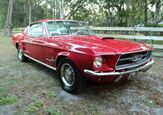


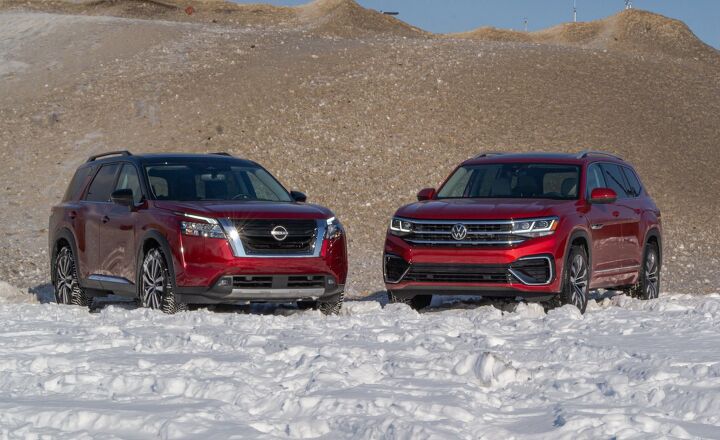









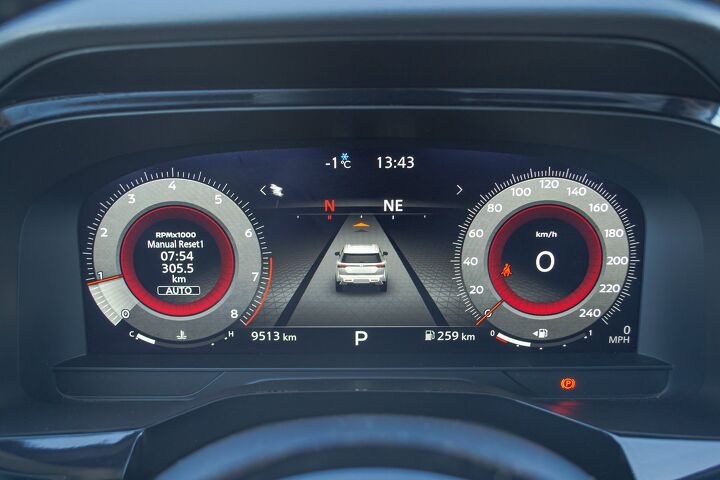
























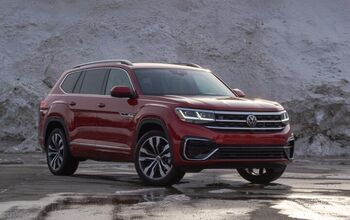
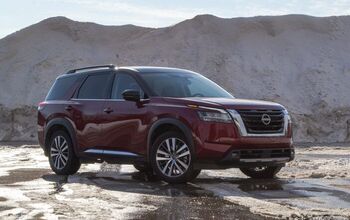
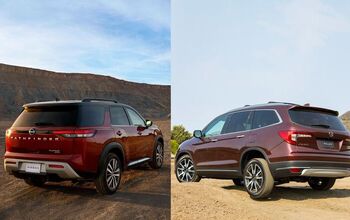

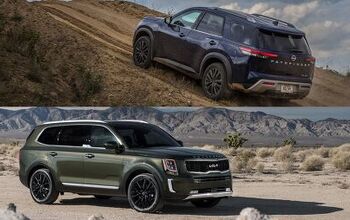











Comments
Join the conversation
I own an Atlas and have had many SUVs in the past, to include the highly rated Toyota Highlander, and the Atlas is by far my favorite. I cant believe these reviewers prefer the Nissans look, I find it ugly and the Atlas is the best looking SUV in this category on the market. Also the use of the word modern when describing the Nissans interior has me confused, the more modern appearance is in the Atlas, minimalist design is key to modern aesthetic. Regardless, the Atlas is a fantastic vehicle, the amount of space is truly impressive and another confusion with the article it has the most command of your view than any vehicle I have owned. When opening the panoramic sun roof it feels like your driving in a glass vehicle there is so much view space. I suggest giving it a shot I was looking to buy a Lexus the LX or GX to get similar sizing to the Atlas and I ended up choosing the Atlas after test driving both. The fact that is was tens of thousands of dollars less and I enjoyed it more speaks volumes and apparently a lot of people agree as I have begun seeing a lot of Atlass on the roads these days
Hi Ryan, I totally agree with your comment. After test driving more than 8 different SuVs including; Nissan Pathfinder Range Rover Sport Honda Pilot Range Rover Velar Mitsubishi ?? Forgot the name Mazda Cx9 Acura MdX Gmc Acadia Toyota 4runner We made the easy decision to go with the 2023 Vw Atlas Exec R line, due to its looks and roomy interior. Lets hope it was the right decision.